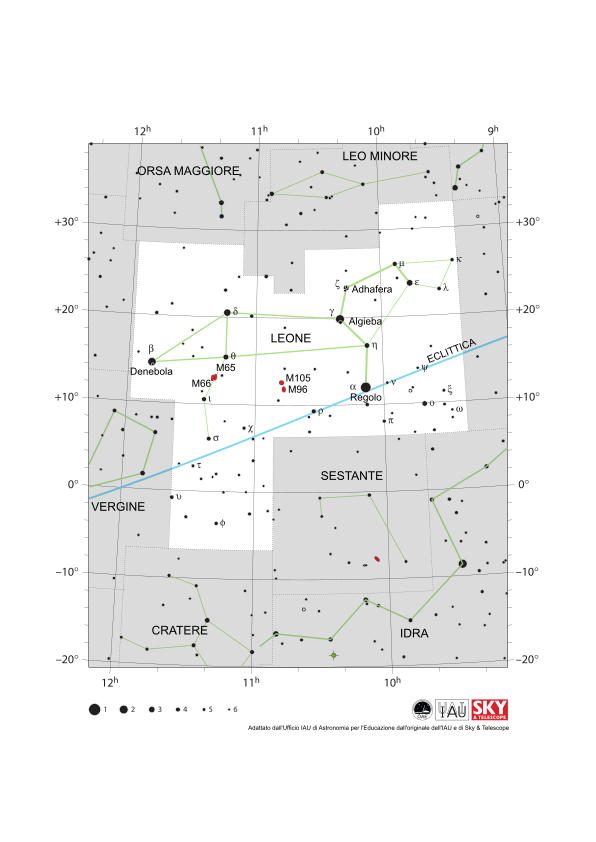This page describes an image Mappa della Costellazione del Leone
Scarica il file PDF (PDF file 199.97 kB)
Diagram caption:
La costellazione zodiacale del Leone e le costellazioni circostanti. Partendo dall'alto del diagramma e procedendo in senso orario, si tratta di Leone Minore, Cancro, Sestante, Idra, Cratere, Vergine e Orsa Maggiore. La stella più luminosa del Leone, Regolo, si trova quasi esattamente sull'eclittica (qui rappresentata da una linea blu): il percorso che il Sole sembra compiere attraverso il cielo nel corso di un anno. Il Sole trascorre il periodo da metà agosto a metà settembre nel Leone. Gli altri pianeti del Sistema solare si trovano spesso nel Leone.
Il Leone si estende sull'equatore celeste e quindi parte di esso è visibile in alcuni momenti dell'anno da tutto il pianeta Terra, con una parte della costellazione oscurata nelle regioni più artiche e antartiche del mondo. Il Leone è maggiormente visibile la sera nella primavera dell'emisfero settentrionale e nell'autunno dell'emisfero meridionale.
Nel Leone si possono osservare diversi oggetti, tra cui M65 e M66, due galassie della Tripletta del Leone, un trio di galassie che comprende NGC 3628, non elencate qui. Inoltre, M96, una galassia a spirale può essere vista come un oggetto sfocato con un piccolo telescopio, e Messier 105, una galassia ellittica. Ognuno di questi oggetti è etichettato sulla mappa come ellissi rossa.
L'asse y di questo diagramma è in gradi di declinazione con il nord in alto e l'asse x è in ore di ascensione retta con l'est a sinistra. Le dimensioni delle stelle qui segnate si riferiscono alla magnitudine apparente della stella, una misura della sua luminosità apparente. I punti più grandi rappresentano le stelle più luminose. Le lettere greche indicano le stelle più luminose della costellazione. Queste sono classificate in base alla luminosità: la stella più luminosa è etichettata come alfa, la seconda più luminosa come beta e così via, anche se questo ordine non è sempre rispettato esattamente. Le linee tratteggiate delimitano i confini delle costellazioni stabiliti dall'IAU e le linee verdi continue indicano una delle forme comuni utilizzate per rappresentare le figure delle costellazioni. Né i confini delle costellazioni né le linee che uniscono le stelle appaiono in cielo.
Diagram credit: Adattato dall'Ufficio IAU di Astronomia per l'Educazione dall'originale di IAU/Sky & Telescope. Link per i Crediti
Stato di traduzione del Diagramma: Non ancora approvato da un revisore
Traduttori del Diagramma: Giuliana Giobbi
Termini di glossario connessi:
Ascensione retta (RA)
, Cancro
, Coordinate celesti
, Costellazione
, Declinazione
, Eclittica
, Galassia
, Galassia a spirale
, Galassia ellittica
, Leone
, Magnitudine apparente
, Vergine
, Zodiaco
Categorie:
Astronomia ad occhio nudo
Diagram license: Creative Commons Attribuzione 4.0 Internazionale (CC BY 4.0) Creative Commons Attribuzione 4.0 Internazionale (CC BY 4.0) icone
In Altre Lingue
Inglese: Leo Constellation MapSpagnolo: Mapa de la constelación de Leo
Cinese tradizionale: 獅子座星圖
Cinese semplificato: 狮子座星图
Se noti un errore in questo diagramma, o nella sua didascalia, per favore contattaci.









